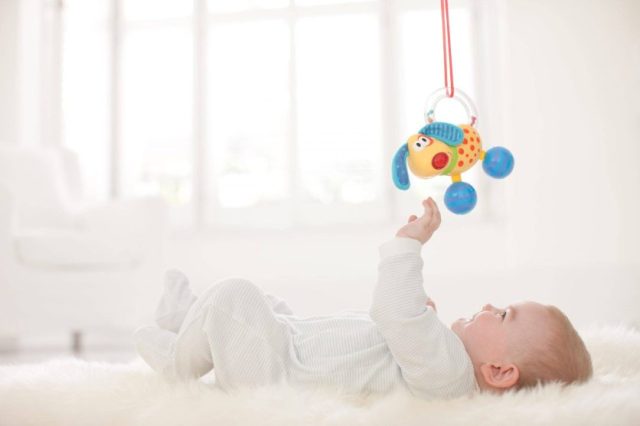Remember when you had disposable income? Now you have a baby, and this innocent little creature has somehow ravaged your credit card statement. It’s no secret that infants are expensive, what with the mass amounts of baby gear they require: diapers and carriers and clothes they won’t stop outgrowing. But there are plenty of ways to cut down on your spending so you can save up for your first vacation with baby or a family photo shoot. These smart, money-saving tips will help you stay on budget during that first (very expensive!) year.
1. Join Your Local Buy/Sell/Trade Groups
Join a Facebook Buy/Sell/Trade group and a Buy Nothing group in your area to find big-ticket items like cribs. You’ll also be able to sell any items that your kid outgrows or didn’t like to begin with. And be sure to check out Rebelstork, a resale website exclusively for baby goods, where you can find name-brand items at great prices. Upcycle your own items, and buy the resold, overstock or open-box gear you need for low prices.
2. Choose Baby Gear That Grows with Your Child
Some high chairs convert into seats for toddlers and older kids. Some cribs can be turned into toddler beds. And some car seats convert from infant all the way to backless boosters. When you’re searching, look for products called 2-in-1 or 3-in-1 to get the most life out of your goods. Here are some products that grow with kids.
3. Borrow, Don’t Buy
Never buy anything until you’ve asked all your friends with older kids if they have the items you need. Lots of parents save gear like bassinets and gliders if they plan to have another child, but they may not be using them at the moment. Maintain what you borrow (and the friendship!) and your friends might just lend you other pricey items, like balance bikes, as your baby gets older.
4. Ask Parents What You Really Need
If you straight talk with other parents before buying the items on your baby list you’ll probably be able to cross off more than a few items. The wipes warmer is a notoriously regretted purchase, and lots of people wish they hadn’t bought fancy baby food makers or baby swings their kid ended up hating (try it before you buy it!). Others discover they prefer the flexibility of a lightweight changing pad over lugging baby over to a changing table for every new diaper. Buy the must-haves and skip the nice-to-haves until you figure out whether your child would actually benefit from them.
Related: Baby Gear You’ll Use Well Beyond the First Year
5. Be Realistic About Your Lifestyle
You’re not likely to drastically change your lifestyle once you have a baby, so if you weren’t an off-road jogger before you probably won’t need a high-tech, pricey jogging stroller. A less expensive traditional stroller should work just great for your walks and errands. If you do decide to take a walk on uneven or unpaved ground, just put your baby in a carrier instead of a stroller, and you’re on your way.
6. Set Up Swaps with Friends
Set up clothing and gear swaps with your mom friends and mom-to-be buddies. Meet up at a local park where you can lay out all the items you’re giving away, or upload photos to a private Facebook group if you can’t all get together. Your pregnant friend might love your baby bathtub, maternity tops and newborn clothes, and you can snap up toys and clothes in your baby’s current size. Meet up a few times a year as seasons and kids’ needs change.
7. Request Group Gifts
For holidays and birthdays, ask family and friends to pitch in for big-ticket items, like a stroller, rather than buying toys or clothes you don’t need.

photo: Ridofranz via iStock
8. Swap Babysitting Duties with a Friend
A free babysitter for date night? Sign us up! Here’s how it works: Ask a couple you know and trust if they’d like to take turns babysitting with you. You babysit your friends’ kid(s) at their house while your partner stays home with your own kid(s) and the other couple gets a night out. Then they return the favor when you want a date night.
9. Sample Different Diapers Before You Buy
Ask moms for the best diaper and wipes and be prepared to get lots of different answers, depending on their babies’ body types, skin sensitivity, and other factors. To find out which ones work best for you, ask friends who use different brands to swap a few (five of each) so you can all test out multiple brands and see which work best for your child.
10. Buy Necessities in Bulk
Once you’ve determined your favorite brands, buying necessities like diapers, wipes and formula in bulk. Signing up for automatic deliveries can also save you lots of money in the long run.
Related: Baby Gear That’s Better to Borrow Than Buy
11. Test Items Before You Invest
They may not be able to talk, but babies have opinions, so don’t stock up on items like bottles and pacifiers until you’ve tested a few. These little ones are known for having strong preferences and changing their minds with no warning. Welcome to parenthood.
12. Stock Up on Clothing Basics in Larger Sizes
If the clothing you like is on major sale, buy items in sizes larger than what your child wears. Stick to items kids can wear year-round, like leggings and socks, rather than guessing what size your child might be in bathing suits and snowpants for next summer or winter.
13. Get Secondhand Special-Occasion Outfits
Hit up Poshmark, consignment shops or yard sales for special-occasion outfits, like holiday-themed baby clothes and fancy dresses. Many have only been worn once or twice and look brand new.
14. Keep Clothes Shopping Simple
We know baby clothes are adorable, but think about what you’ll really use before you splurge. The first few months, babies will mostly be sleeping and lounging at home with you, so onesies are the main thing you need. Babies can wear them on their own, under their clothes and to sleep in, so they’re worth buying in cost-saving multipacks. But you won’t need things like baby shoes until your child is walking outdoors. And if you plan to visit a climate that’s colder or warmer than yours, ask friends if you can borrow weather-appropriate gear instead of investing in something you’ll only wear a few times.
15. Less Is More with Nursery Decor
Once your baby gets mobile, you risk that tiny terror knocking down the glass snow globe before you can stop them. A wipeable playmat, soft pillows to sit and lay on, and baskets to hold toys and stuffies may be all the decor you need until baby gets older.
16. Keep Nursery Style Timeless
It’s so tempting to choose a theme for your nursery and do it up big. But sticking to fewer baby-specific colors and decor items means not having to buy all new stuff in a few years. And the more you can DIY, the cheaper it will be. Try these 16 ways to DIY your nursery on a budget.
17. Babyproof on a Budget
Babyproofing gadgets and services can be really pricey. But there’s a lot you can DIY for cheap, using items you may already own. Consider these 14 DIY ways to make your home safer for baby.
18. Find Free Local Fun
Explore your area for free spots you and your child can visit, from parks and walking trails to your local farmer’s market. A shady outdoor spot or a weekly free night at the museum gets you out of your home without an entrance fee.
19. Check Out Your Local Library
The library can be tons of fun for babies. Many libraries offer storytime and kids’ activities, so check the website or ask a librarian for a schedule of upcoming events. And you can save a lot of money borrowing baby books instead of buying them.

photo: iStock
20. Go Minimalist with Baby Toys
You know the old joke about babies liking the bag the gift comes in more than the gift. Well it tracks. Aside from a comforting lovie, sensory ball, mobile and stuffed animal, babies don’t need lots of store-bought toys. They’re interested in colors, fabrics, textures and noises, so household objects and even your purse or diaper bag hold their attention as well as toys do. And, in fact, interacting with you can provide most of their entertainment. From singing to imitating each other’s sounds and expressions to blowing bubbles and playing peekaboo, there are lots of free, fun ways to entertain your baby and have quality bonding time, which is your child’s all-time favorite thing. When you need a break from the action, give your baby some wooden spoons or plastic measuring cups from the kitchen and watch them have a ball all on their own. Here are 16 baby games you can play together.
21. Create Your Own Baby Classes
Instead of signing up for baby music classes and baby gyms, invite local moms to meet at a local park or other baby-friendly area. Bring small balls and noisemakers and have your own baby class. If you’re not sure what activities to try, YouTube is an amazing resource for free videos of baby gym class, baby music class, baby yoga and more. Watch a few and tailor a class to your kiddos.
22. Start a Mom Workout Group
Stroller workout groups are a great way to prioritize exercise while spending time with your baby and fellow new moms. But just as with the baby classes, ask friends or post on a local Facebook moms group to see who’s interested in meeting up weekly to take a stroller walk and then do a quick workout or stretching session. Again, YouTube is your best friend when it comes to finding high-quality free workouts at all skill levels, and geared to postpartum needs.
23. Don’t Fall for Baby Marketing
No, you don’t need infant Tylenol (cash grab!) or a special baby laundry detergent. Switch to a fragrance-free gentle detergent and you can wash the whole family’s clothes at the same time. The same goes for soap and body lotion. Choose a gentle, fragrance-free brand like Vanicream for baby’s sensitive skin and you can all use the same products.
24. Call Your Pediatrician Before Scheduling a Visit
Every baby concern may not require a doctor’s appointment and the co-pay that goes along with it. Call the nurses’ line first to see if they can help without you coming into the office. Take photos of any rashes or bumps and make detailed notes about your concerns and your child’s symptoms (like what time you noticed the fever and how high it was) to make it easier for them to help you.
25. Skip the Jarred Baby Food
Do you need to buy expensive jars of baby food? Not necessarily. Consider baby-led weaning, in which babies six months and up gnaw on finger foods instead of purees. If you’re not comfortable with that, make your own baby food in bulk from leftovers or fruits and veggies you bought on sale, and store it in your freezer. Freeze the purees you make in ice cube containers. Once frozen, transfer them to plastic bags. Each will be a one-ounce serving you can thaw out and heat up when it’s mealtime.











